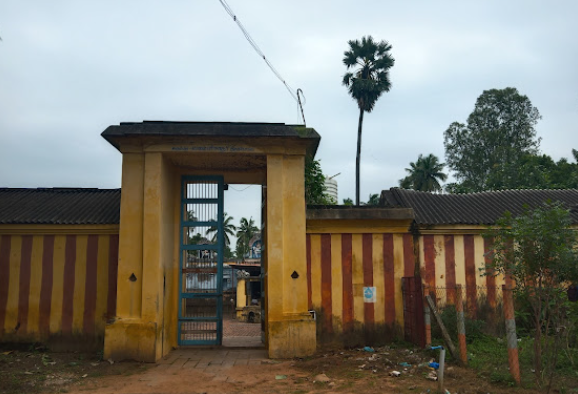Origin/History :-
This ancient temple, believed to be over 2000 years old, was originally constructed by King Abhisithu of the Dravida kingdom. According to the Sthala Puranam, the king worshipped Lord Shiva here and was blessed with a child.
The temple is part of the historical landscape of Kaveripoompattinam (Poompuhar), which is surrounded by seven forests (vanams) and seven temples. These are:
- Thala Vanam (Ganapathy Sthalam) – located at this temple site.
- Chaya Vanam – dedicated to Lord Shiva.
- Pallava Vanam – representing Goddess Parvathy.
- Vellai Vanam (Thiruvengadu) – Natarajar Sthalam.
- Mathanga Vanam (Thiru Nangoor) – Murugan Sthalam.
Mullai Vanam (Thirumullaivoil) and Punga Vanam (Perunthottam) – associated with Bhairavar and Chandikeswarar.
Historically, this place was known by many names, including Thalavanam, Moongil Thoppu, Sangamath Thenthurai, Sangenthi, Vaanor Nagari (Vaanagari), Maal Ma Kudi (Mamakudi), Lakshmi Narayanapuram, Perumpallam, and Thiruvalampuram.
This temple is one of the few among the 276 Paadal Petra Shiva Sthalams that has the Palm tree (Panai) as its Sthala Vriksham. Other temples with Palm trees include Panaiyur, Panankattur, Puravaar Panankattur, Cheyyar, Thirumazhapadi, and Thiruppanandal.
The temple contains six stone inscriptions dating back to the periods of Chola kings Vikraman, Rajathi Rajan II, and Kulothungan III, providing historical evidence of its significance.
Puranic Significance :-
- Sthalapuranam 1 :
According to the Sthala Puranam, Lord Mahavishnu worshiped Lord Shiva at this temple to receive the blessing of a conch (Valampuri Sanghu). Before beginning his penance, Vishnu left Goddess Lakshmi here to assist Goddess Parvathy. Pleased with Vishnu’s devotion, Lord Shiva blessed him with the Chakrayudam (discus) and Ghatha (club). Upon returning to this place to retrieve Goddess Lakshmi, Goddess Parvathy presented him with the conch and the lotus (Pathmam). As a result, the place came to be known as Valampuram, reflecting the significance of the conch.
- Sthalapuranam 2 :
Another significant legend associated with this temple is that of Sage Heranda (Athreyar) Maharishi. According to the story, during Shivaratri in Thiruvalanchuzhi, Aadhiseshan emerged from the Padhala Logam (underworld) to worship Lord Shiva. His emergence created a large hole (phila dwaram), and the nearby river Cauvery flowed into this hole, disappearing into the underworld. Harithuvajan, the Chola king ruling from Kumbakonam, was alarmed by this and prayed to Lord Shiva for a solution. It is said that Lord Shiva’s divine voice proclaimed that either a king or a sage had to sacrifice their life by entering the hole to restore the river.
The king sought advice from Sage Heranda Maharishi, who was performing penance in this region. The sage confirmed the divine message. When the king prepared to sacrifice himself for the people’s welfare, Sage Heranda Maharishi stopped him and took the responsibility himself. He entered the hole, successfully bringing the river Cauvery back to the earth at a place called “Mela Cauvery” near Kumbakonam. Though he entered the underworld elsewhere, it is believed that he reemerged at this temple site. Afterward, the sage worshipped Lord Shiva here for some time before attaining salvation.
There is a shrine dedicated to Heranda Maharishi’s Jeeva Samadhi in front of this temple, where a Shivalingam worshipped by the sage is also enshrined.
- Sthalapuranam 3 :
Another legend associated with this temple is that of King Dhananjaya from the Magadan empire. Before his death, he instructed his son to dissolve his ashes in a holy theertham where they would miraculously transform into flowers. His son, King Dakshina, and his wife travelled to various Shiva temples in search of such a sacred water body. Upon visiting this temple, the ashes transformed into flowers, fulfilling the king’s wish. King Dakshina then dissolved the ashes in the temple’s theertham and worshipped Lord Shiva here. The temple holds idols of King Dakshina and his wife to commemorate this event. As per the Puranas, this temple is considered as sacred as Banaras (Kasi).
- Sthalapuranam 4 :
Another legend tells of a king from Kasi who wanted to test the fidelity of his queen. While camping in the forests, he instructed his minister to falsely inform his wife that he had been killed by a tiger during the hunt. Overcome with grief, the queen immediately died. For causing the death of a chaste woman through deceit, the king was afflicted with Brahmahathi dosham (a grave sin). Seeking absolution, the king consulted many learned pundits, who advised him to provide Annadhanam (free meals) to 1000 Brahmins daily in Thiruvalampuram. They also instructed him to hang a large bell in front of his palace, which would automatically ring whenever a sage accepted the food.
The king followed the advice and set up a dharamshala where the Annadhanam took place. One day, Saint Pattinathar arrived at the temple and requested food, but the kitchen staff refused as he did not appear to be a Brahmin. Left with no other option, Pattinathar drank the water drained from cooked rice (Kanji in Tamil). Miraculously, the bell began to ring, surprising everyone, as the Annadhanam had not yet started. The king hurried to the dharamshala and found Pattinathar smiling. Realising the saint’s greatness, the king fell at his feet, asking for forgiveness. It is believed that the king was instantly freed from his dosham.
- Sthalapuranam 5 :
It is believed that Daksha and his wife performed penance at this temple to be blessed with a daughter. As a result, Goddess Parvathy was born to them here on a Maham star day in the Tamil month of Maasi, and they named her Dhakshayini.
Lord Shiva is said to have granted darshan to Saint Thirunavukkarasar at this site during his pilgrimage with Saint Thirugnanasambandar.
The temple is also believed to have been a place of worship for many divine beings, including Lord Murugan, Mahavishnu, Brahma, Ekadasa Rudras, Indra, Devas, Lakshmi, Saraswathi, Suryan, Chandran, river Kaveri, Kamadhenu, Iravatham, Thalavana rishis, serpent Vasuki, Sangam, and Varunan.
Additionally, it is believed that Lord Shiva blessed Suryan with the vision of Mount Kailash from this very place.
